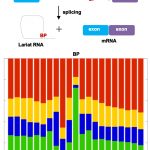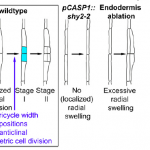Plant Science Research Weekly: April 19th
Review. Multicellular systems biology: Applying network science to plant organ patterning and function
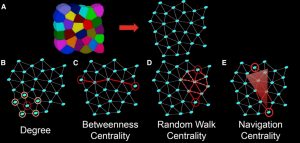 I really enjoyed this review article, which very successfully introduces the reader to the why and how of how to apply network science to plant science. Bassel never veers off into abstraction or “math-speak”, but instead roots his explanations in familiar biological or ordinary terms. As an example, he describes a structural network as a train route map, but one that does not indicate how often or how fast trains run on each track; incorporating these inputs leads to a functional network. Similarly, a carefully drawn diagram of cells is greatly more useful when it incorporates information about their connectivities, in terms of plasmodesmata and transporters. He then further cements our understanding of the “connectionist approach” through a set of case studies, showing it can be applied to a deeper understanding of various organs: hypocotyl, embryo, and shoot apical meristem. Given that plants cells function in accordance with their position and the activities of their neighbors, the methods described here can help us experience a “cell’s-eye view” and a greater appreciation of how a cell perceives its environment. (Summary by Mary Williams) Mol. Plant 10.1016/j.molp.2019.02.004 For more on the tools and methods that underpin this type of analysis, see Plant Methods 10.1186/s13007‑019‑0413‑0
I really enjoyed this review article, which very successfully introduces the reader to the why and how of how to apply network science to plant science. Bassel never veers off into abstraction or “math-speak”, but instead roots his explanations in familiar biological or ordinary terms. As an example, he describes a structural network as a train route map, but one that does not indicate how often or how fast trains run on each track; incorporating these inputs leads to a functional network. Similarly, a carefully drawn diagram of cells is greatly more useful when it incorporates information about their connectivities, in terms of plasmodesmata and transporters. He then further cements our understanding of the “connectionist approach” through a set of case studies, showing it can be applied to a deeper understanding of various organs: hypocotyl, embryo, and shoot apical meristem. Given that plants cells function in accordance with their position and the activities of their neighbors, the methods described here can help us experience a “cell’s-eye view” and a greater appreciation of how a cell perceives its environment. (Summary by Mary Williams) Mol. Plant 10.1016/j.molp.2019.02.004 For more on the tools and methods that underpin this type of analysis, see Plant Methods 10.1186/s13007‑019‑0413‑0
Review: Towards a sustainable bio-based economy through plant synthetic biology ($)
 Plant synthetic biology is heating up, as ideas and methods initially developed for single-celled organisms are moving into the more interesting and complicated space of multicellular organisms; this leads to greater potentials as well as greater challenges. Why plants? One important reason is that they are photosynthetic, so don’t require the same level of energy input to drive their metabolism that heterotrophic organisms do. Furthermore, plants can easily be grown in fields, avoiding the high costs of fermentation facilities. Shih explores the potential for plant products, primarily sugars and lipids, to be foundation for a bio-economy, through an analysis of cost effectiveness as well as biochemistry. He points out that we don’t have the same tools or deep understanding of plant metabolism that we do of E. coli, and that these deficiencies have collectively limited applications of plant synthetic biology. Finally, the author observes that exploiting the potential of plants for a sustainable bio-based economy still rests on a greater investment in basic plant science research, to fill in our knowledge gaps. (Summary by Mary Williams) Plant Science 10.1016/j.plantsci.2018.03.012
Plant synthetic biology is heating up, as ideas and methods initially developed for single-celled organisms are moving into the more interesting and complicated space of multicellular organisms; this leads to greater potentials as well as greater challenges. Why plants? One important reason is that they are photosynthetic, so don’t require the same level of energy input to drive their metabolism that heterotrophic organisms do. Furthermore, plants can easily be grown in fields, avoiding the high costs of fermentation facilities. Shih explores the potential for plant products, primarily sugars and lipids, to be foundation for a bio-economy, through an analysis of cost effectiveness as well as biochemistry. He points out that we don’t have the same tools or deep understanding of plant metabolism that we do of E. coli, and that these deficiencies have collectively limited applications of plant synthetic biology. Finally, the author observes that exploiting the potential of plants for a sustainable bio-based economy still rests on a greater investment in basic plant science research, to fill in our knowledge gaps. (Summary by Mary Williams) Plant Science 10.1016/j.plantsci.2018.03.012
Review: Synthetic switches and regulatory circuits in plants
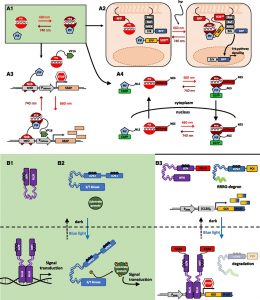 Switches and circuits are key parts of a synthetic biologist’s toolbox. Andres et al. provide historical background and core ideas as well as current understanding of these devices. Switches are defined as components that detect an input signal and transform it into an output signal. Inputs can be chemicals (e.g., tetracycline or dexamethasone) or, light, which is the input signal used in the optogenetics systems. These switches are most useful when very tightly controlled, so that a predictable outcome can be obtained, and also when they don’t alter or interfere with other cellular processes; this latter property is referred to as orthogonality. Many switches have transcriptional responses as their output, but they can also function post-transcriptionally, for example through the production of a gene-silencing RNAi. Genetic circuits are assembled from multiple switches. Circuits can lead to oscillatory responses, bistable states, or form Boolean logic gates that interpret multiple inputs to produce defined outputs, using AND, OR, NAND, and NOR (examples of these are included in the review). The multicellularity and mult-compartmentality of plants provides both opportunities and challenges for implementing these tools beyond those of the simple organisms is which they have been developed. (Summary by Mary Williams) Plant Physiol. 10.1104/pp.18.01362
Switches and circuits are key parts of a synthetic biologist’s toolbox. Andres et al. provide historical background and core ideas as well as current understanding of these devices. Switches are defined as components that detect an input signal and transform it into an output signal. Inputs can be chemicals (e.g., tetracycline or dexamethasone) or, light, which is the input signal used in the optogenetics systems. These switches are most useful when very tightly controlled, so that a predictable outcome can be obtained, and also when they don’t alter or interfere with other cellular processes; this latter property is referred to as orthogonality. Many switches have transcriptional responses as their output, but they can also function post-transcriptionally, for example through the production of a gene-silencing RNAi. Genetic circuits are assembled from multiple switches. Circuits can lead to oscillatory responses, bistable states, or form Boolean logic gates that interpret multiple inputs to produce defined outputs, using AND, OR, NAND, and NOR (examples of these are included in the review). The multicellularity and mult-compartmentality of plants provides both opportunities and challenges for implementing these tools beyond those of the simple organisms is which they have been developed. (Summary by Mary Williams) Plant Physiol. 10.1104/pp.18.01362
Review: Applications of protein engineering and directed evolution in plant research
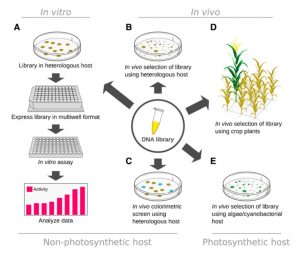 Half of the 2018 Nobel Prize in Chemistry was awarded to Frances Arnold “for the directed evolution of enzymes”. Essentially, this involves modifying an enzyme and screening its properties repeatedly to develop an enzyme with novel attributes. Engqvist and Rabe review this powerful method and its application to plant biology. First, they describe methods for engineering and evolving proteins. These include methods for diversifying sequence (such as error-prone PCR and chimeragenesis) and methods for screening the functions of these new proteins. Much of the remainder of the review discusses pros and cons of various organisms for in vivo functional screening. Ease of transformation, or lack of it, is a key determinant, but for many applications the protein’s activity can only be determined in a multicellular plant. The authors provide several examples of directed protein evolution in heterologous hosts and in plants. (Summary by Mary Williams) Plant Physiol. 10.1104/pp.18.01534
Half of the 2018 Nobel Prize in Chemistry was awarded to Frances Arnold “for the directed evolution of enzymes”. Essentially, this involves modifying an enzyme and screening its properties repeatedly to develop an enzyme with novel attributes. Engqvist and Rabe review this powerful method and its application to plant biology. First, they describe methods for engineering and evolving proteins. These include methods for diversifying sequence (such as error-prone PCR and chimeragenesis) and methods for screening the functions of these new proteins. Much of the remainder of the review discusses pros and cons of various organisms for in vivo functional screening. Ease of transformation, or lack of it, is a key determinant, but for many applications the protein’s activity can only be determined in a multicellular plant. The authors provide several examples of directed protein evolution in heterologous hosts and in plants. (Summary by Mary Williams) Plant Physiol. 10.1104/pp.18.01534
Review: The plant immune system in heterogeneous environments
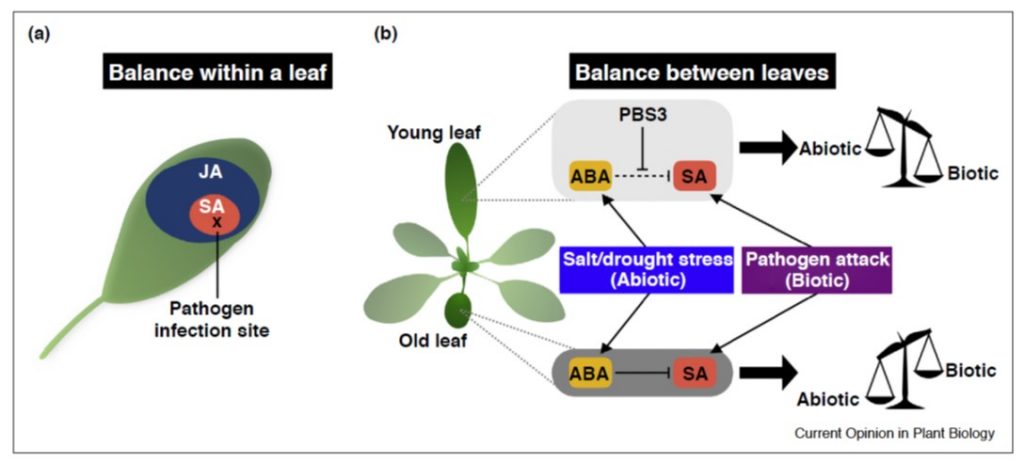 Nobori and Tsuda review how the plant immune system is able to function in heterogeneous environments through its properties of resilience, tunability and balance. They define a resilient system as one where “output remains stable even when part of the system is disabled.” Abiotic factors such as high temperatures and pathogen effectors can disable parts of the immune system, so its continued functioning demonstrates its resiliency. Tunability is when outputs can change depending on the types and amounts of inputs; as an example, the immune system tends to be switched off unless needed, allowing the plant to invest its energy into growth. The molecular underpinnings of resilience and tunability are described and specific examples are reviewed here. Balance is about managing conflicting needs, such as simultaneous attack by multiple pathogens, or abiotic stresses alongside biotic stresses. Less is known about how balance is achieved, but examples of balance are presented. The authors observe that a greater understanding of immune system functions that ensure survival in complex, heterogeneous environments might provide opportunities to increase yields in the relatively homogeneous environments experienced by many crop plants. (Summary by Mary Williams) Curr. Opin. Plant Biol. 10.1016/j.pbi.2019.02.003
Nobori and Tsuda review how the plant immune system is able to function in heterogeneous environments through its properties of resilience, tunability and balance. They define a resilient system as one where “output remains stable even when part of the system is disabled.” Abiotic factors such as high temperatures and pathogen effectors can disable parts of the immune system, so its continued functioning demonstrates its resiliency. Tunability is when outputs can change depending on the types and amounts of inputs; as an example, the immune system tends to be switched off unless needed, allowing the plant to invest its energy into growth. The molecular underpinnings of resilience and tunability are described and specific examples are reviewed here. Balance is about managing conflicting needs, such as simultaneous attack by multiple pathogens, or abiotic stresses alongside biotic stresses. Less is known about how balance is achieved, but examples of balance are presented. The authors observe that a greater understanding of immune system functions that ensure survival in complex, heterogeneous environments might provide opportunities to increase yields in the relatively homogeneous environments experienced by many crop plants. (Summary by Mary Williams) Curr. Opin. Plant Biol. 10.1016/j.pbi.2019.02.003
Structure and activation of a plant NLR resistosome ($)
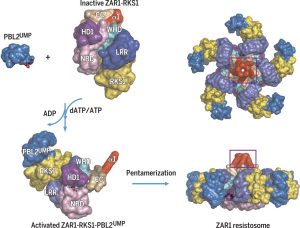 The 2017 Chemistry Nobel Prize went to the developers of cryo-electron microscopy, and this method is transforming plant science as well as other life sciences. In a pair of back-to-back papers, Wang et al. used cryo-EM to examine how ZAR1, a CC-NLR protein [Coiled-coil (CC) nucleotide-binding (NB), leucine-rich repeat (LRR)], interacts with its partners and targets in mounting resistance. The authors examine the structures of ZAR1 in various states of activation and with various partners, and examine how removal of various domains affects activity in vivo. Not unexpectedly, the nucleotide binding domain binds ADP or ATP, with nucleotide exchange controlling its activitation, and the LRRs are involved in pentamerization and active complex formation. In the pentamer, the coiled-coil (CC) domains form a central helical barrel that is critical for function and that may interact with the membrane. These studies also allow the authors to compare the plant resistome to various animal defense complexes including apoptosomes and inflammasomes. The work presented is a remarkable and exciting achievement that opens doors to new insights into how the plant immune system functions. (Summary by Mary Williams). Science 10.1126/science.aav5870 and 10.1126/science.aav5868; see also 10.1126/science.aax0174 for a Perspective.
The 2017 Chemistry Nobel Prize went to the developers of cryo-electron microscopy, and this method is transforming plant science as well as other life sciences. In a pair of back-to-back papers, Wang et al. used cryo-EM to examine how ZAR1, a CC-NLR protein [Coiled-coil (CC) nucleotide-binding (NB), leucine-rich repeat (LRR)], interacts with its partners and targets in mounting resistance. The authors examine the structures of ZAR1 in various states of activation and with various partners, and examine how removal of various domains affects activity in vivo. Not unexpectedly, the nucleotide binding domain binds ADP or ATP, with nucleotide exchange controlling its activitation, and the LRRs are involved in pentamerization and active complex formation. In the pentamer, the coiled-coil (CC) domains form a central helical barrel that is critical for function and that may interact with the membrane. These studies also allow the authors to compare the plant resistome to various animal defense complexes including apoptosomes and inflammasomes. The work presented is a remarkable and exciting achievement that opens doors to new insights into how the plant immune system functions. (Summary by Mary Williams). Science 10.1126/science.aav5870 and 10.1126/science.aav5868; see also 10.1126/science.aax0174 for a Perspective.
Detection and stealth at the wall: glycosidases and glycans in flagellin peptide recognition ($)
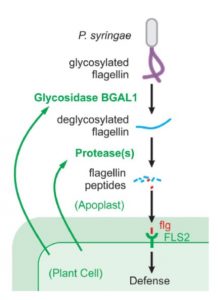 Bacterial flagellin is a well-known microbial pattern that triggers plant immune responses. Flagellin is a glycosylated protein polymer. The immunogenic domain is buried within the protein structure as well as beneath a glycan layer. Buscaill et al. set out to identify how this immunogenic elicitor is exposed and and to what extent this mechanism is subject to the host-pathogen arms race. They found that activity of the plant apoplast-localized glycosidase β-galactosidase 1 (BGAL1) is suppressed in infected tissues, suggesting that the pathogens have a means to prevent the activity. They also showed enhanced susceptibility in plants lacking functional BGAL1. The pathogen-produced BGAL1 inhibitor is a small, heat-stable compound present in the apoplast of infected plants, but not as yet identified. These results clearly show that plants have a way to reveal the immunogenic elicitor which the pathogen has found a way to suppress. The authors additionally demonstrate that flagella with only certain specific glycans are susceptible to BGAL1 action, indicating that glycan polymorphism is a common strategy to evade detection. This article identifies a new battle site in the ongoing war between plants and pathogens. (Summary by Mary Williams). Science 10.1126/science.aav0748
Bacterial flagellin is a well-known microbial pattern that triggers plant immune responses. Flagellin is a glycosylated protein polymer. The immunogenic domain is buried within the protein structure as well as beneath a glycan layer. Buscaill et al. set out to identify how this immunogenic elicitor is exposed and and to what extent this mechanism is subject to the host-pathogen arms race. They found that activity of the plant apoplast-localized glycosidase β-galactosidase 1 (BGAL1) is suppressed in infected tissues, suggesting that the pathogens have a means to prevent the activity. They also showed enhanced susceptibility in plants lacking functional BGAL1. The pathogen-produced BGAL1 inhibitor is a small, heat-stable compound present in the apoplast of infected plants, but not as yet identified. These results clearly show that plants have a way to reveal the immunogenic elicitor which the pathogen has found a way to suppress. The authors additionally demonstrate that flagella with only certain specific glycans are susceptible to BGAL1 action, indicating that glycan polymorphism is a common strategy to evade detection. This article identifies a new battle site in the ongoing war between plants and pathogens. (Summary by Mary Williams). Science 10.1126/science.aav0748
A high‐throughput transient expression system for rice
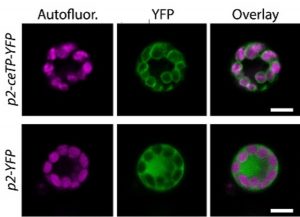 Transient expression platforms allow short-term expression of candidate genes in the host plant, without the integration of DNA into the host genome. The expression cassettes are delivered to the host cells either by Agrobacterium- or microprojectile-mediated approaches. Agrobacterium-mediated transformation is laborious as it needs mature plants, significant time-gap between transformation and observation of results, and also, it induces widespread gene expression changes that influences the dynamics of transgene expression. Microprojectile-based bombardment approach is expensive and requires specialized equipment to achieve transient expression in host cells. Given this, Page et al. have developed a highly-efficient polyethylene glycol (PEG)-mediated protoplast transformation protocol for transient expression in rice. The optimized protocol reported a transformation efficiency of 30%. The procedure is “cheap” as it requires no expensive chemicals, equipment or reagents, “fast”, with imaging possible 16 hours post-transformation, and “robust”, as it could be coupled to any high‐throughput cloning platform (Summary by Muthamilarasan Mehanathan) Plant Cell Environ 10.1111/pce.13542
Transient expression platforms allow short-term expression of candidate genes in the host plant, without the integration of DNA into the host genome. The expression cassettes are delivered to the host cells either by Agrobacterium- or microprojectile-mediated approaches. Agrobacterium-mediated transformation is laborious as it needs mature plants, significant time-gap between transformation and observation of results, and also, it induces widespread gene expression changes that influences the dynamics of transgene expression. Microprojectile-based bombardment approach is expensive and requires specialized equipment to achieve transient expression in host cells. Given this, Page et al. have developed a highly-efficient polyethylene glycol (PEG)-mediated protoplast transformation protocol for transient expression in rice. The optimized protocol reported a transformation efficiency of 30%. The procedure is “cheap” as it requires no expensive chemicals, equipment or reagents, “fast”, with imaging possible 16 hours post-transformation, and “robust”, as it could be coupled to any high‐throughput cloning platform (Summary by Muthamilarasan Mehanathan) Plant Cell Environ 10.1111/pce.13542
EXPANSIN A1-mediated radial swelling of pericycle cells positions anticlinal cell divisions during lateral root initiation
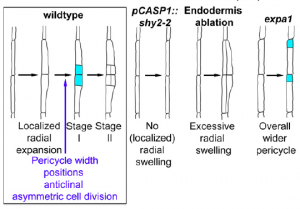 Lateral root development helps plants explore the soil for mineral nutrients and water, and there are environmental and internal cues that precede the formation of lateral root primordia. In Arabidopsis thaliana, some of these internal cues include increased auxin concentrations around lateral root founder cells and their radial expansion. Ramakrishna et al. used an auxin-inducible lateral root proliferation system alongside non-degradable auxin-response repressors (IAA14 and IAA3) to identify genes involved in the early development of lateral root primordia. EXPA1, a cell wall remodeling protein, was identified through transcriptomic analysis, and subsequent microscopy demonstrated cell patterning irregularities during stage I in lateral root primordia of the expa1 mutant, as well as a delay in progression to stage II. (Summary by Nathan Scinto-Madonich) Proc Natl. Acad. Sci. USA 10.1073/pnas.1820882116
Lateral root development helps plants explore the soil for mineral nutrients and water, and there are environmental and internal cues that precede the formation of lateral root primordia. In Arabidopsis thaliana, some of these internal cues include increased auxin concentrations around lateral root founder cells and their radial expansion. Ramakrishna et al. used an auxin-inducible lateral root proliferation system alongside non-degradable auxin-response repressors (IAA14 and IAA3) to identify genes involved in the early development of lateral root primordia. EXPA1, a cell wall remodeling protein, was identified through transcriptomic analysis, and subsequent microscopy demonstrated cell patterning irregularities during stage I in lateral root primordia of the expa1 mutant, as well as a delay in progression to stage II. (Summary by Nathan Scinto-Madonich) Proc Natl. Acad. Sci. USA 10.1073/pnas.1820882116


